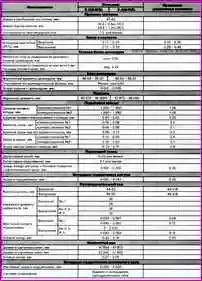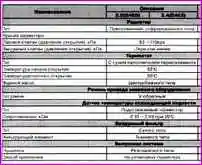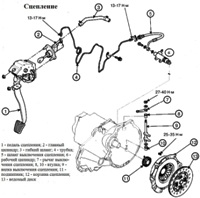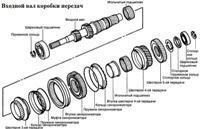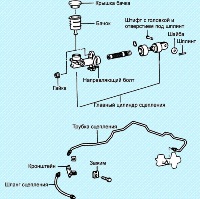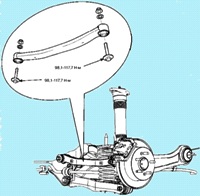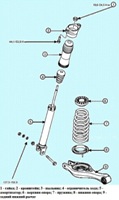Remove the rest of the gasket from the cylinder head connector surface using a scraper
Using a soft brush and solvent, clean the cylinder block.
Using a special ruler and a set of feelers, measure the flatness of the surface of the cylinder head connector.
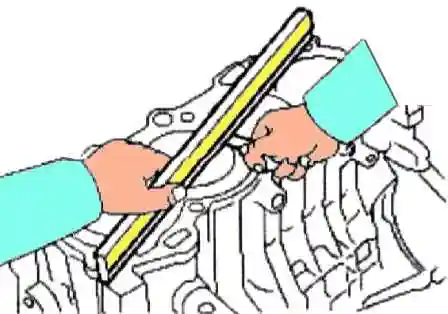
Standard out-of-flatness value: less than 0.05 mm.
Visually check the cylinder mirror for deep scratches and burrs.
If defects are found, replace the cylinder block assembly.

Using a bore gauge, measure the inner diameter of the cylinders in two perpendicular planes in three places.
Standard inner diameter: 86.00 ~ 86.03 mm.
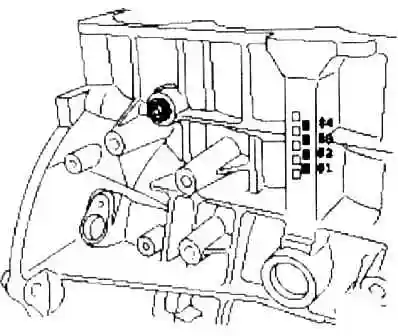
Measurement location (from the bottom of the cylinder block): 110.7 mm / 160 mm / 210 mm
Check the cylinder size code on the bottom of the cylinder block
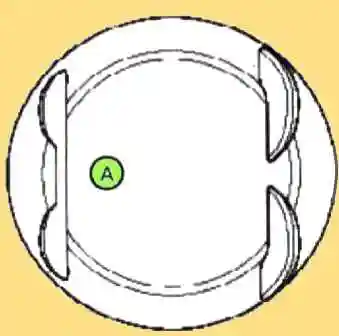
Choose the piston in relation to the inner diameter of the cylinder block.
The clearance between piston and cylinder should be 0.02 ~ 0.04mm.
|
Class |
Code |
Internal diameter cylinder, mm |
|---|---|---|
|
A |
A |
86.00 ~ 86.01 |
|
B |
B |
86.01 ~ 86.02 |
|
С |
С |
86.02 ~ 86.03 |
Check the piston size code (A) on its bottom (shown in the picture).
|
Class |
Code |
Outer diameter piston, mm |
|---|---|---|
|
A |
A |
85.975 ~ 85.985 |
|
B |
B |
85,985 ~ 85,995 |
|
С |
С |
85,995 ~ 86,005 |
Pistons and piston rings
Clean piston rings.
Using a special scraper, remove carbon deposits from the surface of the rings.
Using a special tool or a broken ring, clean out the rings in the piston.
Using a solvent and a brush, rinse and clean the piston.
Do not use a metal bristled brush when cleaning
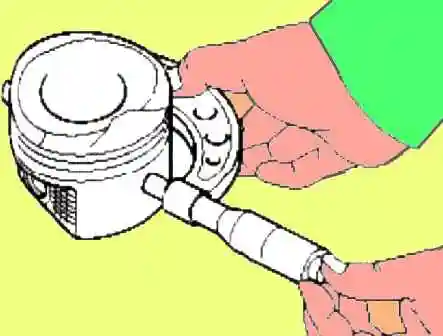
Using a micrometer, measure the outer diameter of the piston in the plane of the transverse axis of the piston pin and at a distance of 47 mm from the bottom, as shown in the figure.
Standard piston diameter: 85.975 ~ 86.005 mm.
The difference between the outer diameter of the piston and the inner diameter of the cylinder is the clearance.
Standard value: 0.015 ~ 0.035 mm.
Measure the backlash of the piston rings.

Using a set of feeler gauges, measure the gap between the new piston rings and the cut in the piston.
Standard side clearance:
- 0.05 ~ 008mm (compression #1),
- 0.04 ~ 0.08mm (compression #2)
- 0.06 - 0.15 mm (oil scraper).
Maximum side clearance:
0.1mm (compression #1), 0.1mm (compression #2) and 0.2mm oil scraper.

If the piston ring gap exceeds the allowable value, it is necessary to replace the piston assembly.
Check the gap in the locks of the piston rings, for this:
Install the piston ring into the cylinder.
Then, move the ring inside the cylinder using the piston as shown.
Measure the blockage in the lock using a set of probes.
If the gap in the lock exceeds the allowable limit, it is necessary to replace the ring with a new one.
If the gap in the lock is too large, it is necessary to measure the inner diameter of the cylinder.
If the cylinder diameter exceeds the allowable limits, it is necessary to replace the cylinder block assembly.
Standard gap in the lock of the ring:
- 0.15 ~ 0.30mm (compression #1),
- 0.37 - 0.52 mm (compression #2),
- 0.20 ~ 0.70mm (oil scraper).
Maximum allowable limits:
0.5 (compression #1) , 0.7 mm (compression #2).
Piston pins
Using a micrometer, measure the outside diameter of the piston pin.
Standard value: 21.000 ~ 21.006 mm.
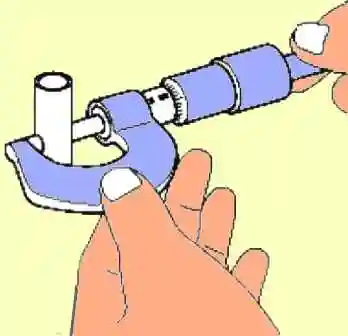
Measure the clearance between the piston pin and the bore in the piston. Standard gap size: 0.01 ~ 0.02mm.
Measure the difference between the outside diameter of the piston pin and the inside diameter of the connecting rod end sleeve. Standard value: 0.016 ~ 0.032 mm.
Oil pressure switch
Check the voltage between the terminal and the housing. If not, replace the switch.
Check the voltage between the terminal and the housing by pressing on a thin wire. If not, replace the switch.
If there is no voltage when the air pressure in the oil hole is 50 kPa, the switch is OK.
Check for air leakage. If there is a leak, the diaphragm is damaged. It should be replaced.
Installation of the cylinder-piston group
Wash all parts before assembly.
Before installing parts, apply a thin layer of engine oil to all friction surfaces.
Replace all gaskets, O-rings and O-rings.
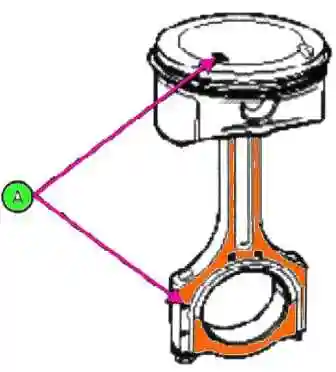
Assemble the piston with the connecting rod.
Using a hydraulic press, press the piston pin into the piston.
make sure that the piston and connecting rod alignment marks are directed towards the timing chain.

Install piston rings.
Install the oil scraper spacer with two side rails, by hand.
Using the tool, install the two compression rings with the identification marks facing up.
Arrange the piston rings so that the locks are located as shown in the figure below.
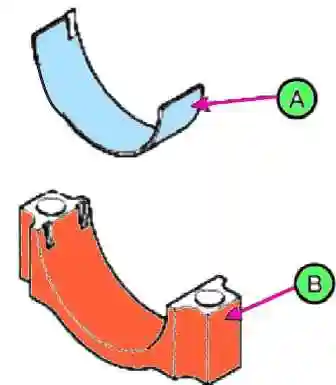
Install the bearing shells.
Align the tab on the bushing (A) with the notch on the connecting rod and connecting rod cap (B).
Install the bearings into the connecting rod and the connecting rod cap as shown.
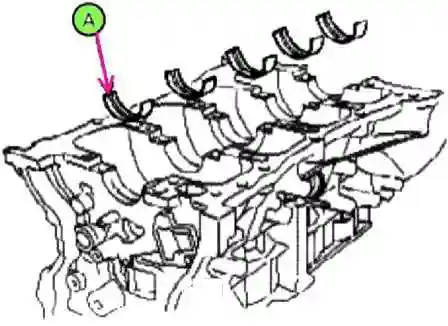
Install the crankshaft main bearing shells.
The upper main bearing shells installed in the cylinder block have recesses for supplying engine oil, while the lower ones do not have recesses.
Align the lugs on the bearings with the recesses on the cylinder block. Install the bushings in the five crankshaft bearings (A) as shown.
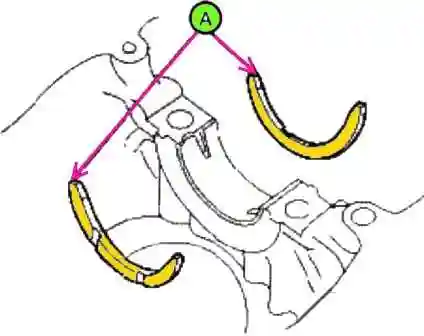
Align the lugs on the bushings with the recesses on the main bearing caps. Install earbuds.
Install the thrust bearings on the 3rd support.
Inserts must be installed in recesses from the support, as shown in the figure.
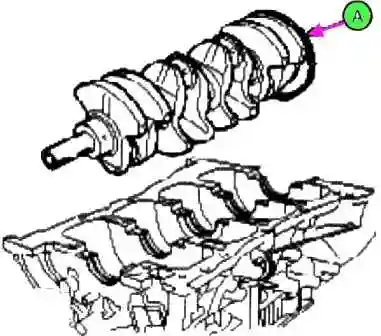
Install the crankshaft into the cylinder block
Install the main bearing caps on the cylinder block.

Install the main bearing cap bolts.
The main bearing cap bolts are tightened in two steps.
If any defects are found in the bolts, they must be replaced.
Apply a thin layer of engine oil to the threaded part of the boots.
Install and tighten the 10 mounting bolts in two steps, in the sequence shown in the figure. Tightening torque: 29.4 Nm.

Install the mounting bolts 120’ in the order shown in the figure.
Check and make sure the crankshaft rotates smoothly.
Check the end play of the crankshaft.
Install pistons with connecting rods.
Before installing the pistons in the cylinders, apply a thin layer of engine oil to the grooves under the rings and the cylinder mirror.
Remove the connecting rod caps and gently slide the rubber hose over the threads of the connecting rod bolts.
Install the piston ring compression tool.
Then install the piston in the cylinder and, applying light blows with the wooden handle of the hammer, insert it into the cylinder.
Stop when the spring compressor is released.
Check that the connecting rod is correctly aligned with the crankshaft.
Install the connecting rod caps and tighten the mounting bolts. Tightening torque: 19.6 Nm + 90˚.
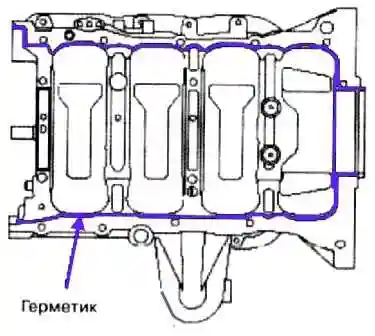
Apply sealant to the cylinder block crankcase connector surface as shown.
Install the crankcase within 5 minutes of applying the sealant. Apply sealant to the threads of the bolt holes.

Install the crankcase (A) on the cylinder block.
Tighten the mounting bolts to the torque:
- step 1: 7.8 ~ 8.8 Nm,
- step 2: 151 ~ 18.6 Nm,
- step 3: 23.5 ~ 27.5 Nm.
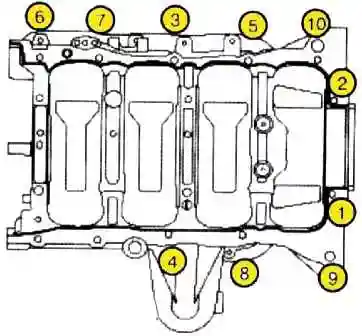
Install a new rear O-ring.
Apply a thin layer of engine oil to the sealing surface.
Using the special tool (09231-H1100, 09214-3K 100) and a hammer, drive in a new sealing collar as shown.
Install the balance shaft module.
install water pump.
Install the crankshaft position sensor (A) and sensor cover. Tightening torque: 3.9 - 5.9 Nm.
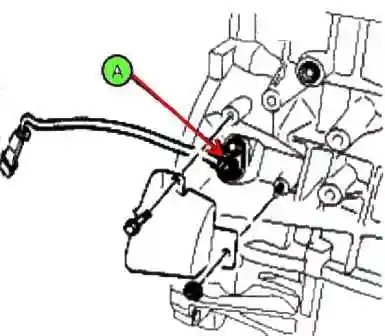
Install pressure sensor.
Apply MS721-39(B) to 2 or 3 threads.
Install the oil pressure switch (A). Tightening torque: 7.8 ~ 11.8 Nm.
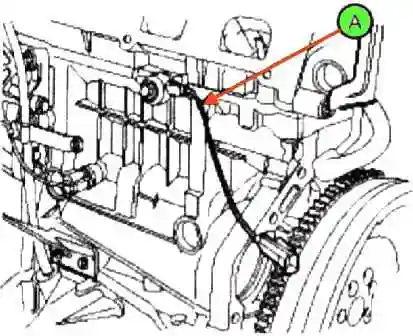
Install the knock sensor (A). Tightening torque: 16.7 ~ 25.5 Nm.

Install the dipstick.
Install a new O-ring on the dipstick.
Apply engine oil to the O-ring.
Install the feeler gauge (A) with the bolt. Tightening torque: 7.8 ~ 11.8 Nm.
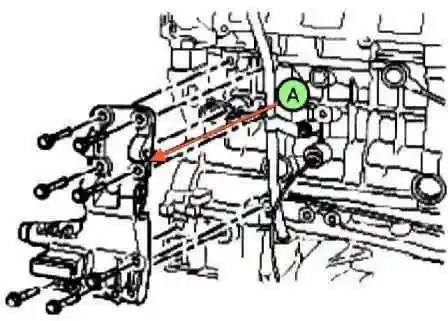
Install the tensioner bracket (A). Torque: 39.2 ~ 44.1
Install the power steering pump bracket and power steering pump.
Install the generator.
Install the air conditioning compressor.
Install the cylinder head.
Install the timing chain.

Install the oil pan.
Using a blade or scraper, remove the old material from the surface of the gasket.
Make sure mating surfaces are clean and dry before applying sealant.
Apply the sealant in even beads placed between the boundaries of the mating surfaces.

To prevent oil leakage, it is necessary to apply sealant inside the threads of the bolt holes.
Install parts within 5 minutes of applying sealant.
After assembling, wait 30 minutes, then add oil.
Install the oil pan (A). Screw in the bolts in order. Tightening torque: M8(B): 26.5~30.4Nm, M6(C): 9.8~11.8Nm.
remove the engine stand.
Install drive disc (A) (automatic gearbox). Tightening torque: 117.7 ~ 127.5 Nm.
Install flywheel (B) (manual gearbox). Tightening torque: 117.7 ~ 127.5 Nm.
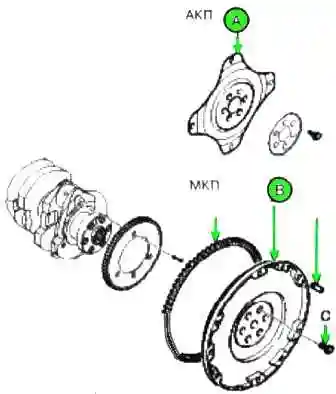
Always use new flywheel (drive plate) bolts.
Apply sealant to the threads of the new bolts (8mm from the bottom of the bolt).
Insert and tighten the 7 bolts.
Specifications for G4KD and G4KE engines
The tables give technical specifications engine ticks:








